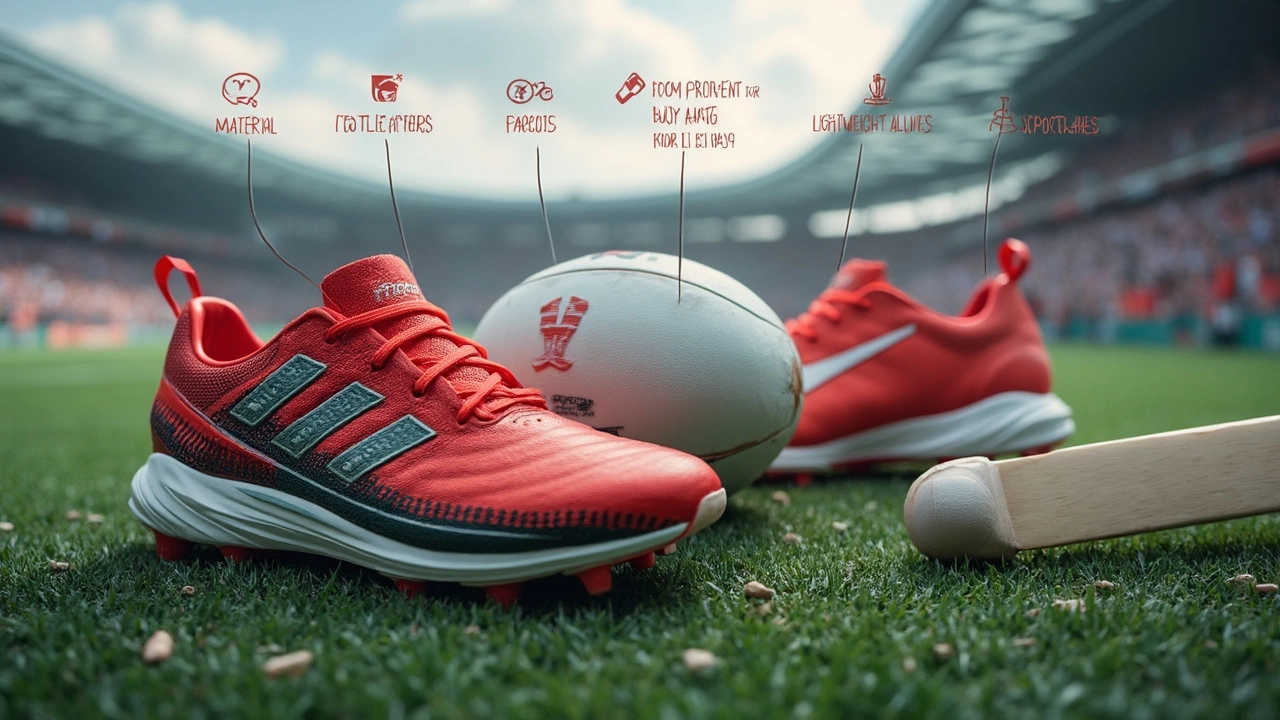What Is Sports Equipment Made Of? Materials That Shape the Game

Grab your favorite soccer ball or bike helmet—ever wondered what it’s actually made of? Materials really make or break sports equipment. From the softness of a tennis grip to the sturdy shell of a football helmet, each piece is crafted for a reason. Knowing what’s inside your gear isn’t just trivia—it could save you money and even keep you safer.
Some gear still relies on time-tested materials, like leather gloves for baseball, but more and more items now mix in tech-driven stuff like carbon fiber and high-impact plastics. This mix of old and new means lighter, tougher, and safer equipment. If you’re in the market for something new, understanding the materials gives you an edge—you’ll get better value and might even tweak your game. Let’s see how all these parts come together to shape the gear you trust every day.
- Classic Materials Used in Sports Gear
- Modern Innovations: The Rise of High-Tech Materials
- Why Materials Matter for Performance and Safety
- Tips for Choosing Long-Lasting Sports Equipment
- Recycling and the Future of Sports Gear Materials
Classic Materials Used in Sports Gear
Let’s get down to what used to make or still makes up the backbone of most sports equipment: those tried-and-true materials you’ll spot in old sports shops and new ones alike. Leather is a big one—you’ll see it on baseball gloves, basketballs, and soccer balls. It’s tough, grippy, and lasts ages if you take care of it. Ever wonder why baseball gloves get passed down? It’s usually the leather holding up, not the stitching.
Wood is another classic. Think baseball bats, hockey sticks, or old-school tennis rackets. Ash and maple are favorites for bats because they’re dense but don’t break too easily. These woods give just the right mix of strength and flex, which is key for hitting a fastball out of the park. And when it comes to hockey sticks, the feel of a wooden blade is still popular among some players, even when carbon fiber versions are everywhere now.
Don’t forget rubber. It’s the heart of so many balls—basketballs, footballs, and even table tennis paddles. Rubber brings the bounce and the grip that makes controlling the ball possible. Plus, it’s affordable and easy to shape in a factory.
Then you have metals like steel and aluminum. Old bikes, golf clubs, and weightlifting gear often use them. Steel brings strength and weight (great for durability), while aluminum drops the weight for things like tennis racket frames and bike parts, making them easier to handle for longer periods.
- If you’re looking for vintage sports gear, check for real leather—synthetic alternatives just don’t age the same way.
- Wooden gear needs regular care; drying it out after use and keeping it out of the rain will help it last longer.
- For classic balls, keeping them dry and away from direct sunlight is key since rubber and leather can both crack or fade.
These traditional materials are still hanging on for a reason—they’re reliable, tough, and in a lot of cases, offer a feel modern tech can’t quite match. The right upkeep goes a long way in making these classic pieces last, whether you’re using them on the field or showing them off on a shelf.
Modern Innovations: The Rise of High-Tech Materials
Sports gear has gone through a huge upgrade, and it’s all about high-tech materials. Stuff like carbon fiber, Kevlar, and smart foams have taken center stage over the last decade. These materials don’t just sound cool—they totally change how equipment feels and performs.
For example, carbon fiber is incredibly light but super strong. That’s why it shows up in tennis rackets, bike frames, and even hockey sticks. This same strength-to-weight combo helps pros swing faster or move with less effort. Kevlar, that tough fiber you hear about in bulletproof vests, is used in some cycling helmets and goalie gear because it can handle serious impacts without falling apart.
Then there’s smart foam. Unlike regular foam padding, smart foam can actually adjust its stiffness depending on the force of a hit. So, helmets with this stuff give you comfort for minor bumps and better protection from the hard blows. It’s a game-changer for sports like football and hockey, where head safety is a big deal.
Check out this quick comparison of high-tech materials and their main uses in sports equipment:
| Material | Typical Use | Benefit |
|---|---|---|
| Carbon Fiber | Bike frames, tennis rackets, golf clubs | Extremely light, super strong, boosts speed |
| Kevlar | Helmets, gloves, pads | Absorbs impact, resists tearing |
| Smart Foam | Helmets, shoulder pads | Adjusts to impact, better protection |
| Thermoplastic | Shin guards, mouthguards | Molds to body shape, easy to clean |
Thanks to modern tech, materials keep getting better. Some brands now combine old-school and high-tech—like shoes with a knit upper for breathability but a carbon plate in the sole for a springy step. If you want to up your game or just want gear that lasts longer, watching out for these new materials can pay off big time.

Why Materials Matter for Performance and Safety
Picking the right material changes the game, literally. The stuff your sports gear is made from can boost your skills or hold you back. That’s not just about comfort—it comes down to how fast you move, how much control you have, and how protected you are when things get intense.
Think about running shoes. Lightweight foam midsoles and mesh uppers mean you’re not dragging extra weight with each step. They also let your feet breathe so you don’t deal with sweaty, slippery runs. On the flip side, heavier or stiffer shoes (with old-school rubber and leather) slow you down and can even cause blisters.
Take helmets next. Hockey and football helmets used to be all about thick leather, but now you’ll find polycarbonate shells and impact-absorbing foam. Polycarbonate is tough and can spread out the force of a hit, while the inner foam eats up the shock, helping you walk away instead of landing in the ER. No wonder pro sports have strict rules about material standards.
Now let’s talk about sports balls. Your standard soccer ball uses synthetic leather, which doesn’t just last longer—it keeps water out, keeping the ball light even in pouring rain. Tennis racquets swapped out wood for graphite and carbon fiber ages ago. These new materials are way lighter and stronger, so they whip faster through the air and help players get more spin on the ball with less effort.
It’s not all about pro athletes. The right material can make a huge safety difference for anyone. Padding made from EVA foam absorbs shock if you wipe out on your skateboard. Shatterproof plastics in goggles keep your eyes safe during racquetball or squash. Even grip tape, which is usually made from rubber or polyurethane, keeps your hands steady and lowers your risk of dropping expensive gear—or injuring yourself.
- If you’re picking out gear, always check for certified safety labels. They’re there for a reason.
- Don’t get tricked by looks—feel the gear, ask about materials, and see what works for your sport and your body.
- If you’re into a sport with risks, like cycling or hockey, never cheap out on protective equipment. The best materials are worth every penny.
The materials in sports equipment aren’t random. They’re chosen to help you play harder, last longer, and—most important—walk away safe no matter what the scoreboard says.
Tips for Choosing Long-Lasting Sports Equipment
Picking sports gear that goes the distance isn’t just luck—it’s about knowing what to look for. Good materials are a huge part of it. Cheap gear might seem like a good deal, but it usually wears out way faster or even falls apart in the middle of play. Here’s how you can spot equipment that’ll stand up to hard use.
- Check the materials: The main keyword in this article is 'sports equipment,' and the best stuff usually uses sturdy plastics, real leather, and metals like stainless steel or aircraft-grade aluminum. For example, tennis racquets made from carbon fiber last longer and handle rough play better than cheap alloy ones.
- Look for solid stitching or seamless construction: Weak seams or glued parts split easily. Baseball gloves stitched with reinforced thread last much longer than those held together with weak, thin thread.
- Go for double or triple layering: Soccer balls with extra bladder layers keep their shape and don’t go flat so fast. Shoes with reinforced toe caps tend to outlive basic models.
- Consider how easy it is to clean: Mold, sweat, and grime ruin gear quickly. Removable liners and washable fabrics make a big difference, especially for helmets and pads.
- Read the warranty: Brands that give 1-2 year warranties usually trust their own products. That’s a good sign of quality.
A quick glance at typical lifespans can help you budget, too. Here’s what you can usually expect:
| Type of Sports Equipment | Average Lifespan (with proper care) |
|---|---|
| Basketball | 1-3 years |
| Bicycle helmet | 3-5 years |
| Soccer cleats | 1-2 years |
| Baseball glove | 5-10 years |
| Tennis racquet | 3-5 years |
One last thing: store your gear right. Don’t leave balls deflated, helmets under the sun, or pads in a damp corner. Proper storage is just as important as the materials themselves for keeping everything looking and working like new.

Recycling and the Future of Sports Gear Materials
Let’s be real, nobody loves tossing old sports equipment in the trash, but most of it ends up there anyway. That’s starting to change, though, thanks to new recycling programs and materials that make it easier to give gear a second life. Big brands like Nike have kicked off recycling drives—Nike’s "Reuse-A-Shoe" program has ground up over 30 million worn-out sneakers to build tracks, courts, and playgrounds. Other companies, like Wilson and Adidas, are experimenting with recycled plastics and plant-based materials for balls and jerseys.
The sports equipment industry is pushing hard for more eco-friendly materials. Some startups are making baseball bats and hockey sticks from bamboo, while others are finding ways to spin recycled fishing nets into tough soccer jersey fabric. Even old wetsuits get a do-over, with companies like Patagonia recycling neoprene into new products. Check out this quick look at where recycled materials are popping up in the sports world:
| Gear Type | Recycled Material Used | Brand/Initiative |
|---|---|---|
| Sneakers | Ground-up rubber/foam | Nike Reuse-A-Shoe |
| Soccer Jerseys | Recycled plastic bottles | Adidas Parley |
| Surfboards | Recycled polystyrene foam | Firewire/EcoBoard |
| Wetsuits | Recycled neoprene | Patagonia |
| Baseball Bats | Bamboo/plant fiber | GreenBat Co. |
There’s no magic fix yet, but watch for labels like “recycled content” or “biodegradable” when buying new gear. If your stuff’s still got miles left, see if your community has a donation program for old equipment. A lot of used gear goes to youth leagues or charities, rather than heading for the landfill.
- Look for brands with take-back or recycling programs—for example, Decathlon and REI accept gear for recycling or resale.
- Cut down plastic use by buying gear made with recycled or natural fibers.
- Hold on to broken gear until a local recycling drive pops up; tech is catching up so these programs are growing fast.
Tech advances are rolling out fast. Scientists are even working on smart materials that break down on their own, making future sports equipment both high-performing and low-impact for the planet.
